A municipality’s master plan is intended to set the vision and start the process of crafting the future of the municipality in regard to several elements, housing, history, culture, open space, transportation, finance, etc. Arlington began a very public discussion about these issues and the development of the Master Plan in 2012. In 2015, after thorough community wide discussion, the Master Plan was adopted by Town Meeting. This year, 2019, the focus is on passing Articles that will amend the current zoning bylaws in order to implement the housing vision that was approved in 2015.
Related articles
The discussions on zoning have been confusing because while zoning covers ALL of Arlington’s land and the zoning bylaws for all Arlington’s zones are referenced, the key issues of greatest interest to Town Meeting are the discussions about increasing density. These discussions pertain ONLY to those properties currently zoned as R4-R7 and the B (Business) districts. These density related changes would affect only about 7% of Arlington’s land area. The map shows the specific zones that would potentially be affected. They lay along major transportation corridors.
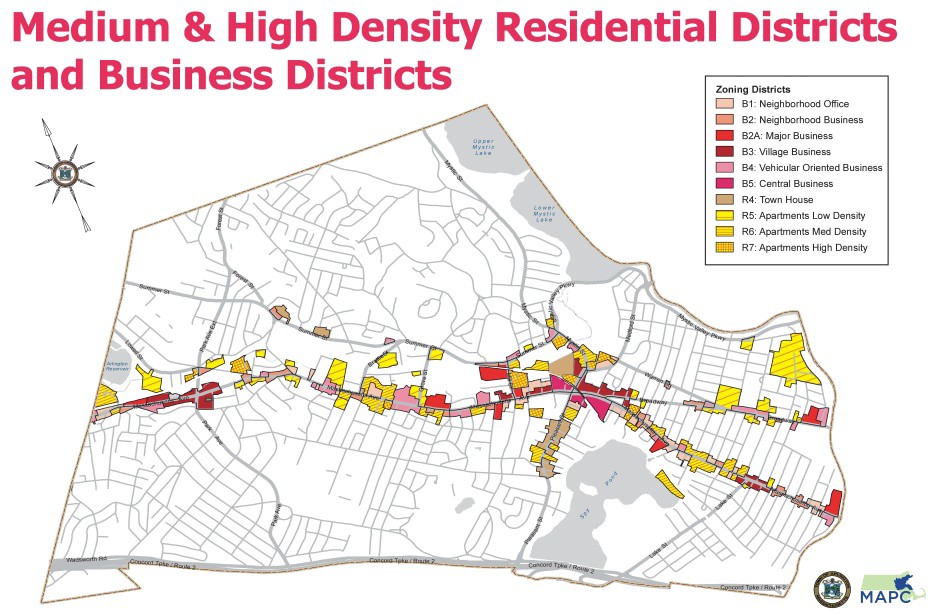
For Arlington’s Nov 2020 Special Town Meeting, my colleague Ben Rudick filed the following warrant article:
ARTICLE 18: ZONING BYLAW AMENDMENT/IMPROVING RESIDENTIAL INCLUSIVENESS, SUSTAINABILITY, AND AFFORDABILITY BY ENDING SINGLE FAMILY ZONING
To see if the Town will vote to amend the Zoning Bylaw for the Town of Arlington by expanding the set of allowed residential uses in the R0 and R1 zoning districts with the goal of expanding and diversifying the housing stock by altering the district definitions for the R0 and R1 zoning districts; or take any action related thereto.
(Inserted at the request of Benjamin Rudick and ten registered voters)
The Inspiration
Our goal with Article 18 is to allow two-family homes, by right, in two districts that are exclusively zoned for single-family homes. This is similar to what city of Minneapolis and the state of Oregon did in 2019. The motivations fall into three broad categories: the history of single-family zoning as a mechanism for racial segregation, environmental concerns arising from car-oriented suburban sprawl, and the regional shortage of housing and its high cost. We’ll elaborate on these concerns in the following paragraphs, and end with a proposed main motion.
Single-family zoning as a mechanism for racial segregation. Single-family zoning began to take hold in the United States during the 1920’s, after the Supreme Court declared racially-based zoning unconstitutional in 1917. Secretary of Commerce Herbert Hoover encouraged cities and towns to adopt single-family zoning ordinances, effectively substituting segregation based on race with segregation based on economic status. The idea was furthered by the Home Owners Loan Corporation of America’s (HOLC’s) redlining maps (created between 1935 and 1940), and the Federal Housing Administration’s (FHA’s) mortgage insurance policies from 1934–1968. The HOLC designated areas with black populations as “hazardous” and actuarially risky, and the FHA used these maps when making underwriting decisions. In short, the FHA was in the business of underwriting loans to white home buyers in white neighborhoods.
Of Arlington’s 7,998 single-family homes, 4,080 (51%) were built during 1934–1968 (per Arlington Assessor’s data). The FHA was the primary mortgage underwriter during this time, and we believe it is reasonable to expect that a substantial number of these homes were originally purchased with FHA mortgages. Put another way, most of our single-family housing was likely built according to FHA guidelines of “avoiding inharmonious mixing or races”, aka segregation. Arlington’s population was 99% white in 1970 and even higher during previous decades. We certainly met the criteria of being a white community.
We believe it’s important to recognize this history, and to have a conversation about how we might restore a balance of fairness.
Environmental concerns. When compared with their multi-family counterparts, single-family homes are less energy efficient, more land intensive, and are associated with higher carbon emissions due to ransportation. Car transportation is a useful analogy; having everyone drive in their own car is more carbon-intensive than carpooling (two-family homes), which in turn is more carbon-intensive than taking the bus (3+ unit buildings). Maps created by Berkeley’s Cool Climate Project show this in a clear way: per household carbon emissions are lower in urban areas than they are in the surrounding suburbs. (Note that authors of the Berkeley report do not advocate getting rid of suburbs, but they do state that suburbs will require different carbon reduction strategies than urban areas).
We believe it is more environmentally responsible to build additional homes on sites that are already developed, rather than (say) going out to the suburban fringes along route 495 and clearing half-acre lots. If we do not provide ample housing within Arlington and other inner-ring suburbs, new workers will likely live further out and have longer, more carbon-intensive commutes. Climate change is a crisis, and our response must involve changing how we live, and that includes ending the twentieth-century pattern of suburban sprawl.
The shortage and high cost of housing. Since 2010, the fifteen cities and towns in the Metro Mayor’s coalition have added 148,000 jobs and 110,000 new residents, but have only permitted 32,500 new homes; this has added to a housing shortage that’s been growing for decades. The imbalance between supply and demand has contributed to rising prices and a very hot market. In 2019, the median sale price for homes in Arlington was $821k. We do not expect construction to be a complete solution to Arlington’s housing costs, but we do believe it is a necessary step in meeting rising demand and counteracting rising costs.
Article 18 is most likely to influence the cost of newly-constructed homes. Newly-constructed single-family homes typically sell in the $1.2M–1.5M range while condominiums in new duplexes typically fall into the $800k–1.1M range. These duplex units are not cheap, but they offer a price point roughly four hundred thousand dollars less than new single-family homes.
We also believe our proposal directly addresses three concerns raised by last year’s multi-family proposal (aka 2019 ATM Article 16):
- Concentration. Last year’s proposal would have concentrated new housing around the town’s business corridors, and Massachusetts Avenue in particular. Article 18 will spread new housing across the majority of the town, as 60% of Arlington’s land area (and 80% of its residentially-zoned land) is currently zoned exclusively for single-family homes (figures provided by Arlingtons Department of Planning and Community Development).
- Height and Shadows. Last year’s proposal would have allowed taller buildings along the commercial corridors; there were concerns about increased height, and the shadows new buildings might cast. Article 18 makes no changes to our zoning bylaw’s dimensional regulation; homes built under this bylaw could be no larger than homes we already allow, by right.
- Displacement. Last year’s proposal drew concerns that businesses and apartment renters would be displaced by new construction. Article 18 applies to districts that are exclusively zoned for single-family homes. 95% of our single-family homes are owner-occupied, and can only be rebuilt or renovated with the owner’s consent. We believe this minimizes any risk of displacement.
Finally, we expect the board will be interested in the number of homes that might be added under this proposal, and the potential impact on the school system. We’ll attempt to address those questions here.
Arlington’s report on Demolitions and Replacement Homes states an average of 27 rebuilds or substantial renovations per year, averaged over a ten year period. For the purpose of discussion, we expect the number of new homes added under this proposed bylaw change to be somewhere between half and double that amount, or 14–54 homes/year. Arlington has 7,998 single-family homes so this is a replacement rate well under 1%/year. It will be nothing like the 500 new homes/year that Arlington was building during the 1920s.
Assessing the impact on the school system amounts (in part) to estimating the number of new school students created by the addition of 14–54 homes/year. One can conceivably see this playing out according to three scenarios. Scenario 1 is simply “by the numbers”. The Housing section of Cambridge’s Alewife District Plan estimates one new student for every 17 new homes (see pg. 145), and the economic analysis of Arlington’s industrial districts gives a net increase of one new student for every 20 new condominiums (see slide 49). Both work out to an increase of 1–3 students per year for the addition of 14–54 homes. This is substantially smaller than past enrollment growth, and something the schools should easily be able to handle.
Second, one could imagine a scenario where elementary school enrollment is in modest decline, as students who entered Arlington public schools in the middle of the last decade move on to middle and high school. Here, new elementary students would utilize existing classroom space, which was created to accommodate students that came before them. It’s a scenario where enrollment stabilizes and doesn’t increase much.
Third, one could picture a scenario where any new home is immediately filled with children. Under this assumption it’s likely that any turnover of single-family homes or suitably-sized condominiums would attract families with children. With 7,998 single-family homes, there is little to prevent another demographic turnover from causing another increase in school enrollment, even if Arlington never adds a single additional home.
In summary, the effects on school enrollment are not easy to predict and several outcomes are possible. Ultimately, this will depend on Arlington’s attractiveness to young families, and our ability to retain these families once their students graduate from school.
Our Proposal to the Arlington Redevelopment Board
We propose that the Zoning Bylaw of the Town of Arlington be amended as
follows:
- By adding the letter “Y” to the “Use Regulations for Residential Districts” table in Section 5.4.3, in the row labeled “Two family dwelling, duplex”, and under the columns labeled “R0” and “R1”;
- By adding the letters “SP” to the “Use Regulations for Residential Districts” table in Section 5.4.3, in the row labeled “Six or more units in two-family dwellings or duplex dwelling on one or more contiguous lots”, and under the columns labeled “R0” and “R1”,
| Class of Use | R0 | R1 | R2 |
| Two-family dwelling | Y | Y | Y |
| Six or more units in two-family dwellings or duplex dwelling on one or more contiguous lots | SP | SP | SP |
and, by making the following changes to the definitions of the R0 and R1 districts in Section 5.4.1(A):
R0: Large Lot Single-FamilyResidential District. The Large Lot Single-FamilyResidential District has the lowest residential density of all districts and is generally served by local streets only. The Town discourages intensive land uses, uses that would detract from the single-family residential character of these neighborhoods, and uses that would otherwise interfere with the intent of this Bylaw.
R1: Single-FamilyR1 Residential District. The predominant uses in R1 are single- and two-family dwellings and public land and buildings. The Town discourages intensive land uses, uses that would detract from the single-family residential character of these neighborhoods, and uses that would otherwise interfere with the intent of this Bylaw.
Related Materials
Our Redevelopment Board Hearing
We presented Article 18 to the redevelopment board on Oct 26th. You can watch the presentation below.
The Redevelopment Board did their deliberations and voting two days later, on October 28th. Their report is available from the Town website.
At least three members of the board were supportive of the effort, but they ultimately voted to recommend this action. I attribute the no action vote to two factors. First, in January 2020 the Redevelopment board agreed to perform a public engagement campaign, to educate residents on housing issues facing the town, and to gather input on how those issues could be addressed. The public engagement effort hasn’t started yet (mainly due to the pandemic), and the board was hesitant to recommend favorable action without doing an outreach campaign first.
Second, the board was interested in attaching standards to single- to two-family conversions, and didn’t feel there was enough time in this town meeting cycle to devise an appropriate set of standards. They were interested in design requirements and collecting payments to an affordable housing trust fund. Standards are interesting idea, and worthy of further consideration. For my own taste, I’d be more inclined to ask for performance standards that tied in to Arlington’s Net Zero Action plan.
So, we are going to take the ARB’s feedback, work on the idea some more, and resubmit during a future town meeting.
by Laura Wiener
If you’ve lived in Arlington for a while, your housing costs, whether you rent or own, might be well below what they are for newcomers. Perhaps you, or someone you know is experiencing scary annual rent increases, or would like to buy a house but can’t get near Arlington’s $1 million-plus median price tag.
Arlington, and much of the Commonwealth, has a shortage of housing that is driving up housing prices and increasing homelessness. Renters are particularly hard hit, with median rents over $2500/month. About 1/3 of Arlington’s renters pay more than 30% of their income for housing. In order to get that rent down to something affordable for a low-income household, subsidies are needed. Arlington has been very supportive of building affordable housing, using its CDBG (Federal Community Development Block Grant) and CPA (local Community Preservation Act) funds to that end. It has also worked cooperatively with the Arlington Housing Authority and Housing Corporation of Arlington in support of their affordable housing projects. These subsidy dollars are necessary but not sufficient for building affordable housing.
Land cost is one thing that makes building any housing expensive, and one way to decrease the cost of building affordable housing is to allow more units to be built on a given piece of land. But our zoning limits much of our town to single- and two-family homes on a lot. The Affordable Housing Overlay allows more units to be built on a lot, throughout the Town, and targets those who need it most—low-income households.
A zoning overlay is an alternative set of zoning requirements that can be applied on a piece of land. A builder can choose to build under the alternative Overlay Zoning rules, or under the original zoning, known as the Underlying Zoning. In this case, the proposed Affordable Housing Overlay Zoning can be applied anywhere, on any lot, if at least 70% of the units are priced to be affordable to a household at or below 60% of median income. If 70% of units are affordable, then the structure can be up to 2 stories taller than with the underlying zoning. In addition, any number of units can be built, so long as yard and setback requirements are met. One additional change is that the parking requirement would be a minimum of ½ space per unit. This reflects the actual parking usage at existing affordable housing owned by the Housing Corporation of Arlington. This proposal includes both rental and ownership units that are affordable.
A group of Arlington residents is proposing an amendment to our current zoning to include an Affordable Housing Overlay. This proposal will come before the Redevelopment Board for hearings in winter 2025 (probably during February or March), and then go to Town Meeting in spring 2025. There has already been one informational meeting on November 7 (slides and video), and there may be additional public informational meetings scheduled.
by Steve Revilak
On Tuesday August 6, 2024, Governor Healey signed the Affordable Homes Act (H.4977) into law. It’s a significant piece of legislation that will take positive strides toward addressing our state’s housing crisis. At 181 pages, the Affordable Homes Act is a lengthy bill, but the things it does generally fall into three categories: funding, changes to state law, and changes to state agencies.
The act authorizes more than five billion dollars to fund the creation, maintenance, and preservation of housing. This includes $425M to housing authorities and local housing initiatives (including $2.5M for the Arlington Housing Authority), $60M to assist homeowners or tenants with a household member with blindness or severe disabilities, $70M for community-based efforts to develop supportive housing for persons with disabilities, and $100M to expand opportunities for first-time homebuyers.
The Affordable Homes Act makes several changes to Massachusetts zoning laws, including the legalization of accessory dwelling units (ADUs) statewide. ADUs, also known as “granny flats” or “in-law apartments,” are a cost-effective way to add new housing, and they’re typically used to provide living quarters for relatives or caretakers, or to generate rental income for homeowners. ADUs are now allowed in all single-family zones in Massachusetts, by right, without the need for a discretionary permit. Arlington has been a leader in this area, having passed an ADU bylaw in 2021, and it’s great to see this option extended throughout the Commonwealth.
Finally, the Affordable Homes Act makes a number of changes to state agencies, especially the Executive Office of Housing and Livable Communities (EOHLC). The Act establishes a new Office of Fair Housing within the EOHLC, to “advance the elimination of housing discrimination.” The Fair Housing office will provide periodic reports on progress towards achieving this goal. EOHLC is also charged with creating and implementing a state-wide housing plan that will consider supply and demand, affordability, challenges unique to different regions of the state, and an analysis of local zoning laws.
While our legislators deserve kudos for putting this package together, they also deserve kudos for what they left out. More than three hundred amendments were filed during House deliberations, and a number of them were intended to weaken the multi-family housing requirements of the MBTA Communities Act. For example, one amendment, simply titled “Technical Correction” would have rewritten the transit community definitions, in order to reduce the housing requirements for Milton. We are heartened that our legislators did not go along with such shenanigans.
from Karen Kelleher, Reporter
Interested in new policy developments on housing production in the Greater Boston area? The latest research from Mass Housing Partnership (MHP) is of interest. They just released (Dec. 18, 2019) in interactive map showing relative housing density around every mass transit and commuter rail station in the system, concluding that the region could add 235,000 units if every community allowed density as of right in the area around transit.
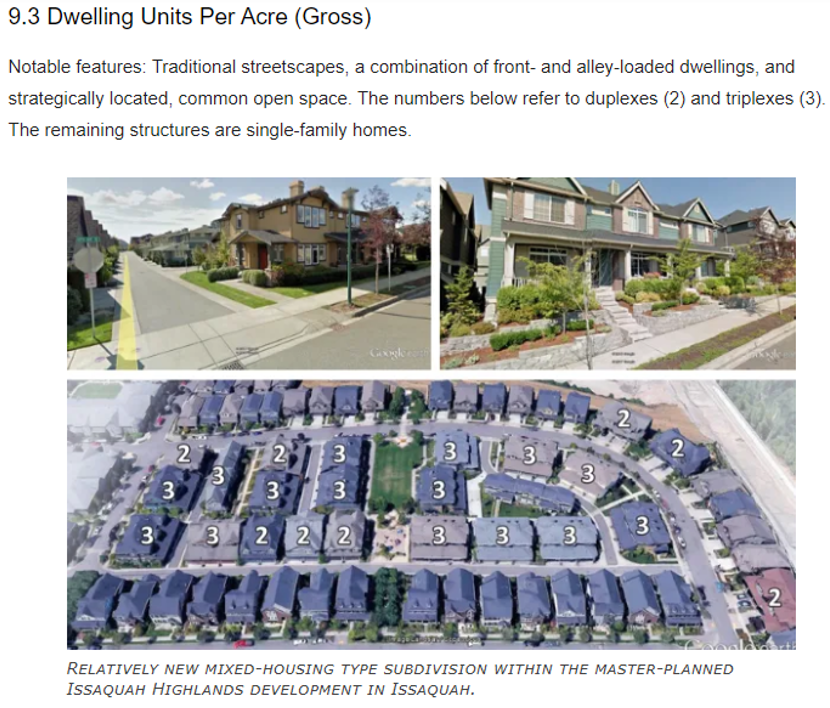
CHAPA has legislation pending that would require municipalities served by transit to allow higher density as of right within a certain distance from transit stations. You’ll see that the density around Alewife is not too bad in the context of the entire system.

This is mostly because of very high density in Cambridge near Alewife, but the density of two and three families in East Arlington shows better housing density than the sea of single family zoning around many commuter rail stops.
You can check it out here:https://www.mhp.net/news/2019/todex-research-brief
by Steve Revilak
The term “AMI” or “Area Median Income” comes up in almost any discussion about affordable housing, because it’s used to set rents and the household incomes for people who are eligible to live in affordable dwellings. AMI is a fairly technocratic concept and my goal is to make the concept (and the numbers) easier to understand.
AMIs are set each year by the U.S. Department of Housing and Urban Development; broadly speaking, an AMI is the median income of a region. Arlington is part of the “Boston-Cambridge-Quincy, MA-NH HUD Metro FMR Area” which consists of more than 100 cities and towns in Massachusetts and New Hampshire. Median incomes represent the “middle” family income of an area—half of households make more, and half make less.
In the process of turning median incomes into income limits, HUD also considers household size: larger households are assigned larger AMI limits than smaller ones, in order to reflect the higher cost of living for more family members.
How do these limits translate into affordable housing regulations? Arlington’s affordable housing requirements (aka “inclusionary zoning”) require that rents for affordable units be priced for the 60% area median income, but the dwellings are available to households making up to 70%. Let’s show an example with some numbers.
| Household size | 60% Income Limit | 70% Income Limit | 60% Rent |
|---|---|---|---|
| 1 | $68,520 | $79,940 | $1,717/month |
| 2 | $78,360 | $91,420 | $1,959/month |
| 3 | $88,140 | $102,830 | $2,203/month |
HUD considers an apartment suitable for a household if it has one bedroom less than the number of household members, so a two-bedroom apartment would be suitable for a household of three, a one-bedroom would be suitable for a household of two, and a studio would be suitable for a household of one. The monthly rent for a two-bedroom apartment would be calculated as follows: $88,140 ÷ 12 × 30% = $2,203. The 30% comes from HUD’s rule that affordable housing tenants should not be cost-burdened, meaning that they pay no more than 30% of their income in rent.$88k or $102k/year can seem like a lot of money (and once upon a time it was). To get a better sense of what these income levels mean, I looked into what kinds of jobs pay these wages. To that end, I found wage information from the Arlington Public Schools report to Town Meeting, the Arlington town budget, and wage data from the Bureau of Labor Statistics. Here are a few scenarios:
Scenario 1: single adult
Scenario 1 represents a single adult living alone, and earning between $68,520 and $79,940. Jobs in this pay range include:
- Elementary classroom teacher ($62,000 – $75,000)
- Town planner ($75,000 – 79,000)
- Animal Control Officer ($72,000)
- Firefighter ($73,640)
- Librarian ($70,395)
- Lab Technician ($70,710)
- Social Worker ($71,470)
- Subway operator ($72,270)
- Licensed Practical Nurse ($75,690)
- Paralegal ($77,500)
- Chef ($78,040)
- Carpenter ($78,000)
Scenario 2: single parent with household of two
Scenario 2 represents a single parent earning between $78,360 and $91,420/year. Jobs in this pay range include:
- Office Manager – Assessor’s office ($80,399)
- Assistant Town Clerk ($77,375)
- Town Engineer ($74,000 – $80,000)
- Police Department Patrol Officer ($87,000)
- Town Budget Director ($88,488)
- Telecommunications equipment installer ($80,350)
- Plasterer and Stucco Mason ($82,250)
- Electrician ($82,380)
- Cement Mason ($86,250)
- Plumber and pipe fitter ($90,580)
Scenario 3: household of two, both adults
Scenario 3 has two adults, each earning $39,180 – $45,710 per year. Jobs in this salary range include several that we’ve come to know as “essential workers” during the pandemic.
- Special education teaching assistant ($34,290)
- Arlington Public Schools Paraprofessional ($36,290 – 42,440)
- Substitute Teacher ($34,921)
- Inspectional Services Record Keeper ($44,481)
- Food preparation worker ($39,590)
- Bartender ($39,730)
- Childcare worker ($40,470)
- Ambulance Driver ($40,890)
- Waiter ($41,440)
- Pharmacy aide ($41,460)
- Bank teller ($42,270)
- Tailor and dressmaker ($43,790)
- Restaurant cook ($44,140)
You may have noticed gaps in these lists — for example, there are no jobs listed in the $50,000 – $60,000 range because it’s in between the income limits for one- and two-income households. It’s also worth noting that a fair number of town employees’ salaries would qualify them for affordable housing (the town is Arlington’s largest employer).
So who qualifies to live in affordable housing? People with a lot of ordinary, working-class jobs, including many town employees.
You may not know who your Town Meeting Members are. You may not even know what precinct you live in. We’re here to help!
What’s My Precinct?
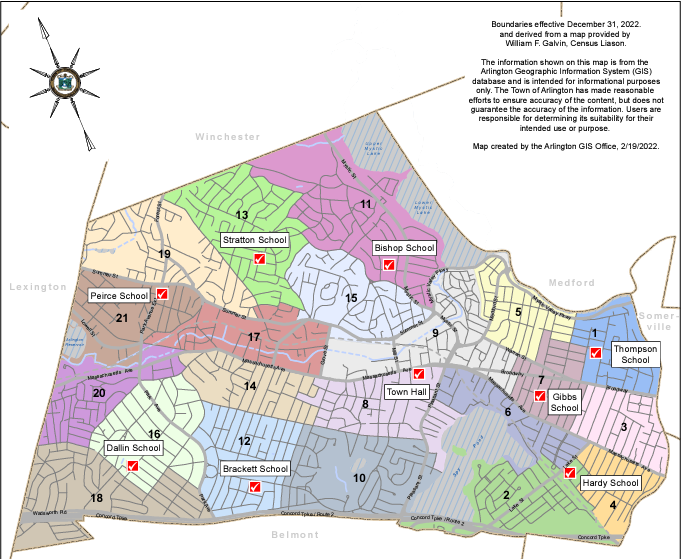
This PDF map of Arlington is divided by precinct. You may need to zoom in to see your precinct.
Who Are My Town Meeting Members?
The town of Arlington has a public list of town meeting members and their contact information. Send them an email telling them how you feel, or ask them if you can take a walk and discuss the MBTA Communities Plan.
Restrictive covenants are a “list of obligations that purchasers of property must assume … For the first half of the 20th century, one commonplace commitment was a promise never to sell or rent to an African American”. [1] These covenants gained popularity after the Supreme Court’s 1917 decision in Buchanan v. Warley.
Rothstein’s book The Color of Law mentions examples from Brookline, MA; Arlington, MA has examples of it’s own. We’ll look at one from an East Arlington deed dating to 1923. Credit to Christopher Sacca for finding these documents.
First, a land plan to establish content. Below is the subdivision plan for a farm owned by Herbert and Margaret Allen. I count a little over 200 lots in this subdivision. The plan itself states that “no single house shall cost less than $6,000 and no double house shall
cost less than $8,000″. This language also appears in the property deed.
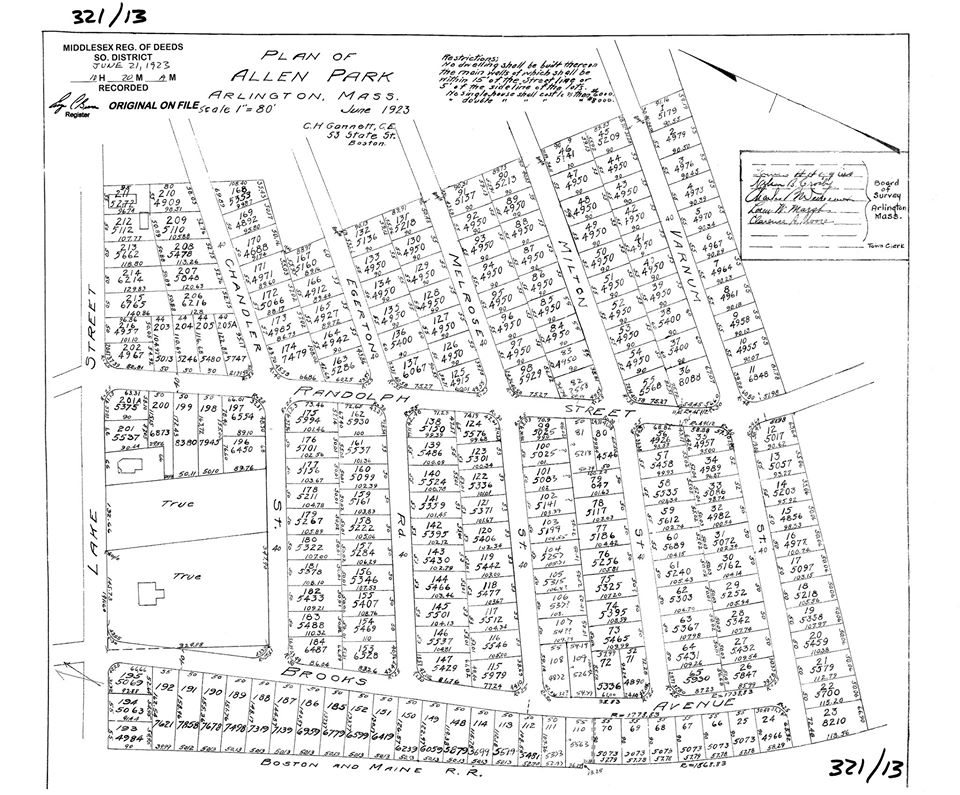
One of the deeds from these parcels appears in book 4631 page 218 and book 4631 page 219, in the Southern Middlesex registry of deeds.
Here’s page 218; the deed begins at the bottom.
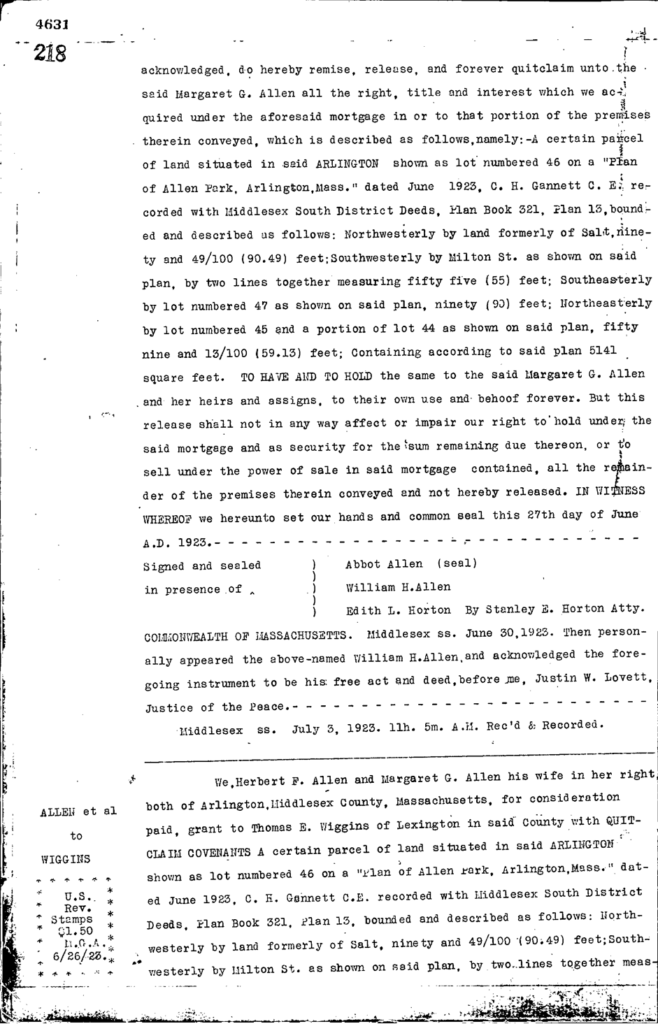
Here’s page 219. The racial covenant appears halfway down the page. It reads “No sale or lease of any said lots shall be made to colored people, no any dwelling on any said lots be sold or occupied by colored people”.
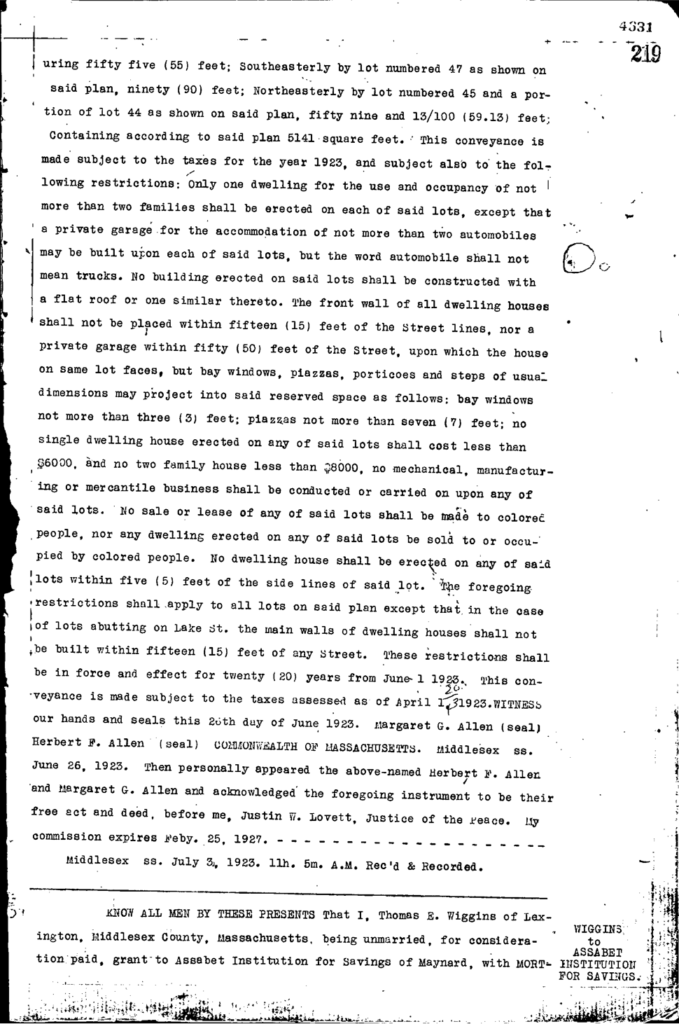
The 1920’s were a time of significant residential growth in Arlington, as farmers (called “Market Gardeners” at the time) subdivided and sold off their land. This example shows that Arlington, MA landowners employed some of the same discriminatory tactics for segregation as other communities in the United States. It would take further research to determine how common the use of such covenants was early twentieth-century Arlington.
Footnotes
[1] The Color of Law. Richard Rothstein. pg. 78